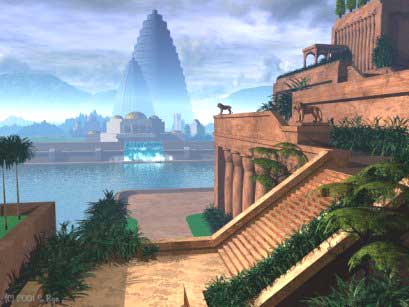Rise of Babylonia
The name of Babylon means “The Gate of God(s)” and was the capital
of the land of Babylonia. Nimrod, a descendant of Noah, established the city
and common religion. It was here where the tower of Babel was located and where
God confused the speech of the builders. No wonder Babylon became a biblical
symbol of the confusion that can be caused by godlessness.


Babylonia was the ancient country of Mesopotamia; know originally as Sumer and later as Sumer and Akkad, lying between the Tigris and Euphrates rivers, south the modern Baghdad, Iraq, that became an independent city-state around 1824 B.C based on agriculture rather than industry, after also became the religious center of the kingdom this dynasty reached its peak when Hammurabi became in Babylon`s king. The city was the administrative center of a great kingdom.
Hammurabi was a brilliant war leader, his
armies fought many battles to expand his power and he was the ruler who chiefly
established the greatness of Babylon, the world`s first metropolis, the most
remarkable of the Hammurabi records is his code of laws.
He defeats his rivals in the region, and establishes a society based on the rule of law. By the end of his reign the whole of Mesopotamia is under central control for the first time since the empire of Sargon, 500 years earlier.
Babylon is destroyed in about 1531 BC by invaders from the northwest, the Hittites. But Babylon re-establishes itself a century later under the rule of intruders from the northeast.
He defeats his rivals in the region, and establishes a society based on the rule of law. By the end of his reign the whole of Mesopotamia is under central control for the first time since the empire of Sargon, 500 years earlier.
Babylon is destroyed in about 1531 BC by invaders from the northwest, the Hittites. But Babylon re-establishes itself a century later under the rule of intruders from the northeast.
Although Hammurabi`s Code is not the first
code of laws, it is the best preserved legal document reflecting the social
structure of Babylon during Hammurabi`s rule
Hammurabi’s Code
Accordin to http://www.historyguide.org/ancient/hammurabi.html the Code of Hammurabi is the longest surviving text from the Old Babylonian period. Almost completely preserved, the code is far more significant in legal history than any of its forerunners, such as that of Ur-Nammu. 282 laws, carved in forty-nine columns on a basalt stele, address a variety of topics in civil, criminal, and commercial law. Like other Near Eastern codes. Hammurabi's does not attempt to cover all possible legal situations. In its epilogue, Hammurabi describes the code as "laws of Justice" intended to clarify the rights of any "oppressed man
In the code of Hammurabi laws were given laws that regulated the form of everyday life and punishing crime.Regulated trade, rents, divorce, property, the penalties of crime of robbery, murder, etc
The code was carved upon a black stone monument, eight feet high, and clearly intended to be reared in public view. This noted stone was found in the year 1901, not in Babylon, but in a city of the Persian mountains, to which some later conqueror must have carried it in triumph.
The code of laws applies to the entire Babylonian society. The penalties of the code varied according to the status of the victim. There were three classes in the Babylonian society: the patrician, who were the free men and women; the plebeians, who were the commoners; and the slaves. While the patricians were protected by the law of retaliation, the lower classes received only monetary compensation.
The purpose of the Code of Hammurabi was to use political power to create common bonds among the diverse people of the society. It greatly influenced a total dependence on the power of their one ruler, and it was a conscious effort to exalt the king as the source, the only source, of earthly powers. It unified the empire by offering the standards for moral values, class structure, gender relationships, and religion. It was the most important of all Mesopotamian contributions to civilization.
The code was carved upon a black stone monument, eight feet high, and clearly intended to be reared in public view. This noted stone was found in the year 1901, not in Babylon, but in a city of the Persian mountains, to which some later conqueror must have carried it in triumph.
The code of laws encouraged people to accept authority of a king, who was trying to give common rules to govern the subjects' behavior. The Code of Hammurabi begins with a prologue, which describes the time that Hammurabi first becomes king.
The code of laws applies to the entire Babylonian society. The penalties of the code varied according to the status of the victim. There were three classes in the Babylonian society: the patrician, who were the free men and women; the plebeians, who were the commoners; and the slaves. While the patricians were protected by the law of retaliation, the lower classes received only monetary compensation.
The purpose of the Code of Hammurabi was to use political power to create common bonds among the diverse people of the society. It greatly influenced a total dependence on the power of their one ruler, and it was a conscious effort to exalt the king as the source, the only source, of earthly powers. It unified the empire by offering the standards for moral values, class structure, gender relationships, and religion. It was the most important of all Mesopotamian contributions to civilization.

References:
http://history-world.org/babylonia.htm,A project by History World International, World History Center
http://www.fordham.edu/halsall/ancient/hamcode.asp,Translated by L. W. King
This document originates from the Internet, via World Wide Web, at gopher://gopher.vt.edu:10010/11/
http://www.thenagain.info/webchron/middleeast/hammurabicode.html, Edited by: Keren Gelfand
Researched by: Rebecca EngelmannWritten by: Amalia Giokaris
October 13, 1999
Revised March 2003
,

